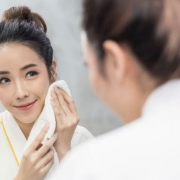Don’t be Duped by These 5 Skincare Myths
If you’ve been paying attention to current beauty and health trends, you know we’re amid a skincare revolution. More brands, products, and tools are available to help you maintain your skin health than ever before.
Don’t chalk this trend up to mere vanity, though—taking good care of your skin is about more than just wanting to stay youthful-looking. As your body’s largest organ, the skin also plays a vital role in regulating body temperature, manufacturing vitamin D, and acting as your first line of defense against harmful germs. It only makes sense that you’d want to take the best possible care of it.
But sometimes you sabotage yourself with your best intentions. Believing some common skincare myths can cause (or worsen) the very skin problems you’re trying to correct or avoid. Learn fact from fiction as we bust five widely believed skincare fallacies and offer tips to making skin-friendly choices.
Myth 1: There is one right kind of skincare regimen.
Sure, most of the generic cleansers you can find at any supermarket or drugstore will remove dirt and oil from your skin. And any moisturizer will provide some boost in hydration. But to really see positive results and make your skin its happiest, you need to give it exactly what it needs.
The first step in adopting a bespoke (read: personalized) skincare regimen is to understand your skin type. Small pores with rough, flaky patches? You probably have dry skin. If you tend to get blackheads and need a blotting tissue every afternoon, you’re likely on the oily side of the spectrum. Or, you could be a combination of both if you see midday shine in your T-zone (forehead, nose, and chin) but are scaly around your cheeks. If you tend to be easily irritated, you could have sensitive skin. If you’re still unsure what category you fall into, take this skin type quiz to find out.
Whatever your skin type, choose a regimen that supports the health of your all-important skin barrier to help you look and feel your best. The protective outer layer of skin contains a lipid or moisture barrier that protects you from your environment and keeps natural moisture in. When your skin barrier is performing at its best, your skin looks firm and plump. It also has a natural dewy glow. Keeping your moisture barrier healthy is important to get the results you want to see in the mirror.
A bespoke skincare regimen can be as simple as cleansing and moisturizing or as robust as the Korean 13-step routine. However many steps you choose, make sure each product in your regimen is geared toward your skin type. In general, the following are common staple products of a skincare regimen:
- Cleanser: Look for a mild cleanser to use morning and night. If you wear makeup, it’s best to remove it in a separate step prior to washing—called the two-step cleaning process.
- Toner: It’s not just an important step only for those with combination or oily skin. Toning can also help moisturize dry skin. This category has boomed in recent years, and you can find toners that include a wide variety of ingredients, from rose water to kombucha. Toning right after cleansing helps lock in your natural hydration and prepares your skin for moisturizing, but this is the most optional step.
- Serum: Also known as an essence or ampoule, serums may contain a broad range of ingredients—including plant extracts, oils and nutrients—that focus on types of skin concern. You only need a few drops, as these products are highly concentrated.
- Eye cream: While your skin is absorbing the serum, use your ring finger to gently tap the eye cream or gel of your choice into the skin surrounding the eye socket. Don’t swipe or rub in the product, as that can cause pulling in an area with thin, delicate skin.
- Moisturize: Like serums, moisturizers are also often tailored to your skin needs. For your daytime moisturizer, look for one with a broad spectrum SPF of at least 30, or apply a sunscreen separately after your moisturizer.
Myth 2: You only need skincare for your face.
That skin barrier we discussed above? It covers and protects the skin all over your body. That means the rest of it needs just as much care and attention as the skin on your face.
To baby the delicate skin you’re in and pamper those often-neglected body parts:
- Take cooler, shorter showers. Prolonged exposure to heat can cause damage to your moisture barrier, which can lead to dryness, redness, and irritation.
- Pat, don’t rub, yourself dry with a towel. Excessive rubbing can tug at your skin, which can cause immediate irritation and a loss of elasticity in the skin over time.
- Moisturize daily, at minimum, to lock in the hydration your moisture barrier needs. Use a quality body lotion after showering, and use a facial moisturizer after cleansing both day and night.
- Gently exfoliate all over once to twice a week, especially concentrating on the rougher spots like elbows, knees, ankles, and heels. Use a loofah with a creamy, hydrating body wash or a moisturizing sugar scrub.
- Stay hydrated. Drink the daily recommended 64 ounces of hydrating beverages such as unsweetened teas, coconut water, almond milk, and, of course, water. Dry skin can be an early sign that you’re dehydrated.
- Avoid harsh, drying soaps, facial cleansers, and body washes. Read the product labels and steer clear from those with moisture-sapping sulfates or harsh alcohols.
- Apply sunscreen every day. Protection from the sun’s harmful rays aren’t just for beach days and summer months. The sun can break down your skin’s moisture barrier year-round. See more on this topic below.
- Bring the skincare products you use on your face all the way down to the neck. It needs a similar amount of attention as your face, but the skin on the neck is even thinner.
- Use hand cream, especially with SPF, to keep the age spots at bay. Even if you lie about your age, your hands could betray you.
- Don’t forget your feet! Get rid of calluses by using a pumice stone in the shower. For extra overnight hydration, slather your feet with lotion and wear cotton socks to bed.
Myth 3: The higher the SPF, the better the protection
It seems like the logic should be simple: the higher the SPF number in a sunscreen product, the better it protects against the sun’s harmful rays. The reality, however, is a bit more complicated.
Even though both UVA and UVB rays can damage the skin, SPF typically only measures the amount a product protects against UVB rays—the rays that cause the worst sunburns. If you used certain high-SPF sunscreens, you might not see skin redness or get a sunburn, but that doesn’t mean your skin hasn’t received a high dose of damaging UVA radiation.
Even the SPF numbers themselves can be deceiving. Most people believe that SPF 30 provides double the sun protection that SPF 15 does. In actuality, SPF 15 sunscreen blocks 93 percent of UVB rays, while an SPF 30 product blocks 97 percent.
Further complicating matters, SPF is tested by applying two milligrams of sunscreen to one square centimeter of skin. Most people apply half— or less —that amount. If you skimp on applying sunscreen, you could be much less protected than you assume.
So what’s the sweet spot? Look for an SPF between 30 and 50 that protects against both UVA and UVB radiation. This will often appear on product labels as “broad spectrum,” “multi spectrum,” or “UVA/UVB spectrum.”
For optimal sun protection, apply more sunscreen than you think you need. Be sure to reapply when exposed to direct sun for more than two hours or if you’ve been in the water or exercising. Also take other sun-avoiding measures like seeking shade, wearing loose, light-colored protective clothing, a hat, and limiting time spent in the sun.
Myth 4: Beauty sleep is real only in fairy tales.
Sleeping in until noon on Saturdays will not erase your crow’s feet or banish your smile lines. But a growing amount of research suggests consistently getting a good night’s sleep will do wonders for your skin long term. And, conversely, getting poor rest can have highly damaging effects on the skin.
A study of British women showed pretty conclusive results. All saw an increase of wrinkles, dark circles, and overall dull complexion after five consecutive days of getting only six hours of sleep per night—compared to after getting a night of eight hours of sleep.
The immediate effects of a rough night can be obvious in the form of dark circles under puffy eyes. But the damage sleep deprivation can cause the rest of your skin goes much further.
During sleep, your body goes into repair mode. It gets busy eliminating old, dead cells, making new ones, and cleaning your body of toxins. When you shortchange yourself of a full night’s sleep, you’re missing out on hours of collagen production, which can lead to your skin sagging and looking older sooner. You also won’t get the normal amount of blood flow to your face necessary to give you a healthy, rosy glow.
Lack of sleep also increases levels of the stress hormone cortisol, which can lead to breakouts. Imbalances in pH and loss of moisture are other common byproducts of sleep deprivation, and can wreak havoc on your complexion.
So go ahead and hit the sack a bit earlier to get the recommended seven to nine hours of sleep you need every night. And don’t forget the cardinal rule in skincare: never sleep without first removing your makeup.
Myth 5: Eating greasy foods will make you break out
You’ve probably heard this myth since you were a teenager: if you pig out on chocolate, French fries, or other junk foods, you’ll be promptly rewarded with an unsightly breakout. The old logic was that because oily skin tends to be more prone to imperfections, eating greasy foods will worsen your skin’s oil problems. In reality, oil in your diet doesn’t equate to higher production of sebum (your skin’s natural oil).
Don’t go throwing a parade through your nearest drive-thru just yet, though. What you eat still affects your skin. You are what you eat, and certain foods can trigger hormonal responses that may negatively affect how your skin looks. This is especially true for those that have food sensitivities or allergies. Research has shown that there are some foods that could aggravate problem-prone skin. If that describes you, try staying away from the foods and beverages listed below for a while to see if your skin troubles subside.
- Refined sugars and processed grains. Simple carbohydrates are known to cause spikes in insulin, which messes with the hormones responsible for skin-cell growth and sebum production. More cell turnover combined with more oil can be a recipe for skin disaster.
- Breakouts are typically connected to inflammation, and for people that have any level of sensitivity to it, dairy can really flare things up. While research is conflicted, milk, cream, and ice cream appear to have more negative impacts on the skin, while yogurt and hard cheeses tend to cause fewer issues.
- You’re not going to want to toast to this: alcohol is a nightmare for the skin. Not only is it hard on the liver—the organ responsible for detoxifying your body—but it also dehydrates the body and the skin. Most cocktail mixers come with hefty added doses of sugar, which will cause the dreaded insulin spikes. And in case you thought red wine was exempt because of its noted health benefits, for a lot of people it can cause flushing of the face. If you’re going to imbibe, try not to go overboard, and drink plenty of water. Your skin will thank you the next morning—and in the long run.
It turns out that some of the advice your mother and grandmother gave you about skincare aren’t backed by science or reality. The good news is this golden age of skincare provides more options than ever to make the best choices possible for your unique skin.
References
https://www.niams.nih.gov/health-topics/kids/healthy-skin
http://www.americanskin.org/resource/
https://www.webmd.com/beauty/whats-your-skin-type#1
https://www.ncbi.nlm.nih.gov/pmc/articles/PMC2688147/
https://www.everydayhealth.com/beauty-pictures/delicious-good-for-your-skin-drinks.aspx#01
https://www.webmd.com/beauty/features/beauty-sleep#1
http://www.telegraph.co.uk/goodlife/11618809/How-a-bad-nights-sleep-wrecks-your-skin.html
http://www.goodhousekeeping.com/beauty/anti-aging/a35556/why-is-sleeping-in-makeup-bad/
http://www.yalescientific.org/2011/11/does-greasy-food-cause-acne/
https://www.healthline.com/nutrition/foods-that-cause-acne#section1
https://www.huffingtonpost.com/2013/10/24/alcohol-skin_n_4146391.html













